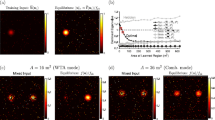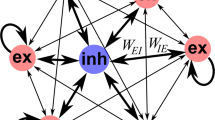Abstract
Cells in several areas of the hippocampal formation show place specific firing patterns, and are thought to form a distributed representation of an animal’s current location in an environment. Experimental results suggest that this representation is continually updated even in complete darkness, indicating the presence of a path integration mechanism in the rat. Adopting the Neural Engineering Framework (NEF) presented by Eliasmith and Anderson (2003) we derive a novel attractor network model of path integration, using heterogeneous spiking neurons. The network we derive incorporates representation and updating of position into a single layer of neurons, eliminating the need for a large external control population, and without making use of multiplicative synapses. An efficient and biologically plausible control mechanism results directly from applying the principles of the NEF. We simulate the network for a variety of inputs, analyze its performance, and give three testable predictions of our model.
Similar content being viewed by others
References
Markus EJ, Barnes CA, McNaughton BL, Gladden VL, Skaggs WE (1994) Spatial informaiton content and reliability of hippocampal CA1 neurons: Effects of visual input. Hippocampus 4: 410–421.
Alyan SH, Paul BM, Ellsworth E, White RD, McNaughton GL,: (1997) Is the hippocampus required for path integration? Society for Neurosci. Abstracts 23: 504.
Angelaki DE, McHenry MQ, Dickman JD, Newlands SD, Hess BJM,: (1999) Computation of inertial motion: neural strategies to resolve ambiguous otolith information. J. Neurosci. 19: 316–327.
Askay E, Baker R, Seung HS, Baker R, Tank D,: (2000) Anatomy and discharge properties of pre-motor neurons in the goldfish medulla that have eye-position signals during fixations. J. Neurophys. 84: 1035–1049.
Askay E, Gamkrelidze G, Seung HS, Baker R, Tank D (2001) In vivo intracellular recording and perturbation of persistent activity in a neural integrator. Nature Neurosci. 4: 184–193.
Benhamou S,: (1997) Path integration by swimming rats. Animal Behav. 54: 321–327.
Chen LL, Lin LH, Barnes CA, McNaughton BL,: (1994) Head-direction cells in the rat posterior cortex: II. Contributions of visual and ideothetic information to the directional firing. Exp. Brain Res. 101: 24–34.
Cho J, Sharp P (2001) Head direction, place, and movement correlates for cells in the rat retrosplenial cortex. Behav. Neurosci. 115: 3–25.
Douglas RJ, Koch C, Mahowald M, Martin KAC, Suarez HH,: (1995) Recurrent excitation in neocortical circuits. Science 269: 981– 985.
Eliasmith C,: (in press), A unified approach to building and controlling spiking attractor networks. Neural Comp.
Eliasmith C, Anderson CH,: (2001) Beyond bumps: Spiking networks that store sets of functions. Neurocomp. 38: 581–586.
Eliasmith C, Anderson CH,: (2003) Neural Engineering: Computation, Representation, and Dynamics in Neurobiological Systems. Cambridge, MA: MIT Press.
Etienne AS, Jeffery KJ,: (2004) Path Integration in Mammals. Hippocampus 14: 180–192.
Frank LM, Brown, EN, Wilson M,: (2000) Trajectory encoding in the hippocampus and entorhinal cortex. Neuron 27: 169–178.
Frank LM, Brown EN, Wilson MA,: (2001) A comparison of the firing properties of putative excitatory and inhibitory neurons from CA1 and the entorhinal cortex. J. Neurophysiol. 86: 2029–2040.
Fyhn M, Molden S, Witter M, Moser E, Moser M,: (2004) Spatial representation in the entorhinal cortex. Science 305: 1258– 1264.
Goldman MS, Levine JH, Major G, Tank DW, Seung HS,: (2003) Robust persistent neural activity in a model integrator with multiple hysteretic dendrites per neuron. Cerebral Cortex 13: 1185– 1195.
Goodridge JP, Touretzky DS,: (2000) Modeling attractor deformation in the rodent head-direction system. J. Neurophy. 83: 3402–3410.
Gothard KM, Skaggs WE, McNaughton BL,: (1996) Dynamics of mismatch correlations between stimuli to spatial correlations between attractors in neural networks. J. Neurosci. 16: 8027– 8040.
Hess BJ, Dieringer N,: (1991) Spatial organization of linear vestibuloocular reflexes of the rat: Responses during horizontal and vertical linear acceleration. J. Neurophysiol. 66: 1805–1818.
Kohler C,: (1986) Intrinsic connections of the retrohippocampal region in the rat brain. II. The medial entorhinal area. J. Comp. Neurol. 246: 149–169.
Kohler C,: (1988) Intrinsic connections of the retrohippocampal region in the rat brain. III. The lateral entorhinal area. J. Comp. Neurol. 271: 208–228.
Koulakov AA, Raghavachari S, Kepecs A, Lisman JE,: (2002) Model for a robust neural integrator. Nature Neur. 5: 775–782.
Markus EJ, Barnes CA, McNaughton BL, Gladden VL, Skaggs WE,: (1994) Spatial informaiton content and reliability of hippocampal CA1 neurons: Effects of visual input. Hippocampus 4: 410–421.
Markus EJ, Qin Y, Leonard B, Skaggs WE, McNaughton BL, Barnes CA,: (1995) Interactions between location and task affect the spatial and directional firing of hippocampal neurons. J. Neur. 15: 7079–7094.
McNaughton BL, Barnes CA, Gerrard JL, Gothard K, Jung MW, Knierim JJ, Kudrimoti H, Qin Y, Skaggs WE, Suster M, Weaver KL,: (1996) Deciphering the hippocampal polygot: The hippocampus as a path integration system. J. Exp. Biol. 199: 173– 185.
McNaughton BL, Barnes CA, O’Keefe J,: (1983) The contributions of position, direction, and velocity to single unit activity in the hippocampus of freely-moving rats. Exp. Brain Res. 52: 41– 49.
Mel B,: (1994) Information processing in dendritic trees. Neural Comput. 6: 1031–1085.
Muller RU, Bostock E, Taube JS, Kubie JL,: (1994) On the directional firing properties of hippocampal place cells. J. Neur. 14: 7235–7251.
Muller RU, Kubie JL,: (1987) The effects of changes in the environment on the spatial firing of hippocampal complex-spike cells. J. Neur. 7: 1935–1950.
O’Keefe J, Dostrovsky J,: (1971) The hippocampus as a spatial map: Preliminary evidence from unit activity in the freely moving rat. Brain Res. 34: 171–175.
O’Keefe J, Recce ML,: (1993) Phase relationship between hippocampal place units and the EEG theta rhythm. Hippocampus 3: 317–330.
O’Keefe J, Speakman A,: (1987) Single unit activity in the rat hippocampus during a spatial memory task. Exp. Brain Res. 68: 1–27.
Page WK, Duffy CJ,: (2003) Heading representation in MST: sensory interactions and population encoding. J. Neurophysiol. 89: 1994–2013.
Quirk GJ, Muller RU, Kubie JL,: (1990) The firing of hippocampal place cells in the dark depends on the rat’s previous experience. J. Neur. 10: 2008–2017.
Quirk GJ, Muller RU, Kubie JL, JBR Jr,: (1992) The positional firing properties of medial entorhinal neurons: description and comparison with hippocampal place cells. J. Neur. 12: 1945–1963.
Redish AD,: (1999) Beyond the Cognitive Map. Cambridge, MA: MIT Press.
Redish AD, Elga AN, Touretzky DS,: (1996) A coupled attractor model of the rodent head direction system. Network: Computation in Neural Systems 7: 671–685.
Redish AD, Touretzky DS,: (1997) Cognitive maps beyond the hippocampus. Hippocampus 7: 15–35.
Redish AD, Touretzky DS,: (1998) The role of the hippocampus in solving the morris water maze. Neural Comput. 10: 73–111.
Samsonovich A, McNaughton BL,: (1997) Path integration and cognitive mapping in a continuous attractor model. J. Neur. 17: 5900–5920.
Seung HS,: (1996) How the brain keeps the eyes still. Proc. Natl. Aca. Sci., USA 93: 13339–13344.
Seung HS, Lee D, Reis B, Tank D,: (2000) Stability of the memory of eye position in a recurrent network of conductance-based model neurons. Neuron 26: 259–271.
Sharp PE,: (1997) Subicular cells generate similar spatial firing patterns in two geometrically and visually distinctive environments: Comparison with hippocampal place cells. Behav. Brain Res. 85: 71–92.
Sharp PE, Blair HT, Etkin D, Tzanetos DB,: (1995) Influences of vestibular and visual motion information on the spatial firing patterns of hippocampal place cells. J. Neur. 15: 173–189.
Skaggs WE, McNaughton BL, Wilson MA, Barnes CA,: (1996) Theta phase precession in hippocampal neuronal populations and the compression of temporal sequences. Hippocampus 6: 149–172.
Taube JS,: (1995) Place cells recorded in the parasubiculum in freely moving rats. Hippocampus 5: 569–583.
Thompson LT, Best PJ,: 1989 Place cells and silent cells in the hippocampus of freely-behaving rats. J. Neur. 9: 2382–2390.
Tolman EC,: (1948) Cognitive maps in rats and men. Psych. Rev. 55: 189–208.
Whishaw IQ, Maaswinkel H,: (1997) Absence of dead reckoning in hippocampal rats. Society for Neur. Abstracts 23: 1839.
Witter MP, Groenewegen HJ, da Silva FHL, Lohman AHM,: (1989) Functional organization of the extrinsic and intrinsic circuitry of the parahippocampal region. Prog. Neurobiol. 33: 161–253.
Witter MP, Ostendorf RH, Groenewegen HJ,: 1990 Heterogeneity in the dorsal subiculum of the rat. Distinct neuronal zones project to different cortical and subcortical targets. Europ. J. Neur. 2: 718–725.
Zhang K,: (1996) Representation of spatial orientation by the intrinsic dynamics of the head-direction cell ensemble: A theory. J. Neur. 16: 2112–2126.
Author information
Authors and Affiliations
Corresponding author
Rights and permissions
About this article
Cite this article
Conklin, J., Eliasmith, C. A Controlled Attractor Network Model of Path Integration in the Rat. J Comput Neurosci 18, 183–203 (2005). https://doi.org/10.1007/s10827-005-6558-z
Issue Date:
DOI: https://doi.org/10.1007/s10827-005-6558-z




